Original text translation: realgu Xiao Gu (X: @0xrealgu)
Translator 0xrealgu notes: Péter Szilágyi from Hungary joined the Geth client development team at the inception of Ethereum and took over team leadership in 2016, continuing until 2024. Today, Geth is the most widely adopted execution layer client, with a market share exceeding 50%; its stability is crucial for Ethereum's security, as even minor software errors could lead to hundreds of millions of dollars in asset losses. Jeffry Wilcke led Geth for the first three years, but after the DAO Hack incident, he experienced severe mental health issues and could no longer continue, passing the leadership to his most outstanding assistant, Peter. (Jeffery Wilcke was also the last co-founder to leave the Ethereum Foundation, aside from Vitalik.)
Over the past decade, Peter has made indelible contributions to Ethereum with his exceptional engineering skills. However, the process of his departure was not dignified. In June of this year, Peter released a series of tweets revealing the truth about his resignation: the foundation secretly supported the Nethermind client while suppressing Geth; they even proposed to "buy out" the Geth team for $5 million, allowing them to establish an independent company and seek their own path; after these conflicts arose, the foundation ultimately "fired" Peter for his insubordination.
The following content is derived from Peter's final speech about Ethereum, which was published on July 23, 2025, titled "Decentralization: Origins and Current Status."
A few months ago, I was invited to speak here (in Romania, at the EthCluj event), and I was a bit conflicted. I'm a technical person, but if I only talk about technology, no one might want to listen. Then I suddenly thought that decentralization is something I care deeply about, but people have too many misconceptions about it, so this is a perfect topic. 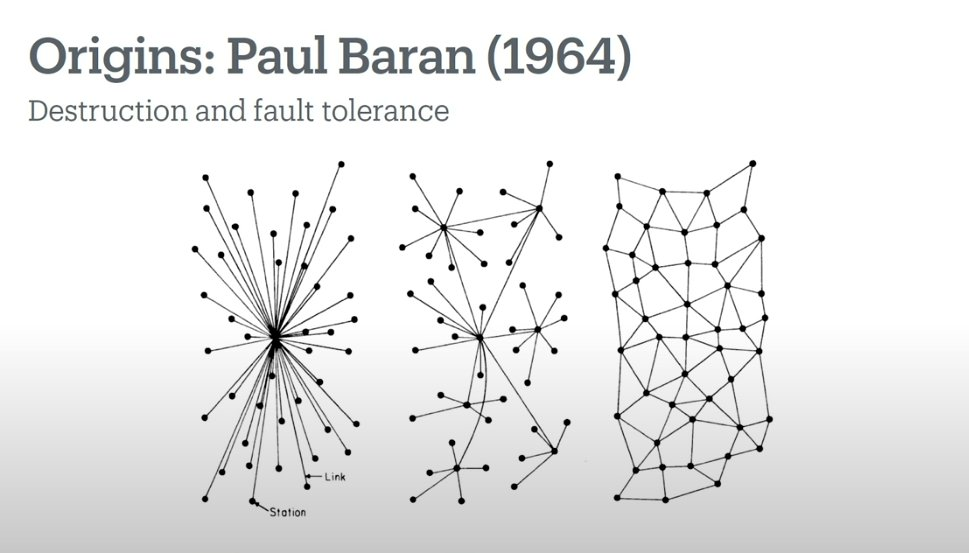
To discuss decentralization, we need to trace back to its roots. In 1964, Paul Baran published a landmark paper. At that time, people were keen on studying various issues in the context of war, and Paul wanted to build a system that could withstand the tests of war. People had already realized that centralized systems (left side of the image) were terrible, as destroying a single node could easily paralyze the entire network.
Then people tended to design network topologies using the structure in the middle of the image because it was hierarchical. Hierarchical structures are not perfect, but they were indeed the best solution at the time. Paul Baran began to analyze it: how many bombs would it take to destroy a hierarchical network? The entire paper discusses the number of bombs needed to destroy the network and the bombing waves. It is a very interesting paper, and at the end of the paper, he proposed a different suggestion: instead of creating these hierarchical structures, why not let all nodes communicate with nearby nodes? (right side of the image)
The truly interesting observation in this paper is that if a network can withstand bombing, it can also withstand failures of its own (some parts). In any computing environment or engineering environment, if you want to make a system more reliable, the costs often increase significantly. So, the more reliable something is, the more expensive it becomes. If we have such a wonderful mesh network that can withstand partial explosions, then what if we no longer pursue 100% reliability? What if we say, okay, let it be 50% reliable? Maybe half of the network will fail, but if it is significantly cheaper, we win.
The second interesting observation is that if we can reduce the operating costs of the network by ten times, we can reinvest the saved money to make the nodes denser, effectively increasing reliability by adding more nodes, leading to a very interesting cycle: lower operating costs, increased node count, and then even lower costs and more nodes.
This paper described the internet before the internet existed, and that is the original definition of decentralization.
This year marks the 10th anniversary of Ethereum's birth. In my view, early Ethereum was very close to perfect decentralization. There were numerous nodes, and everyone had equal opportunities: you had complete state history, full synchronization, and all data was complete. Everyone could participate in mining and create blocks for free. You could mine with a CPU, GPU, or do whatever you wanted. If you wanted to trade, you just sent your transaction to the transaction pool, and everyone could read and execute your transaction. 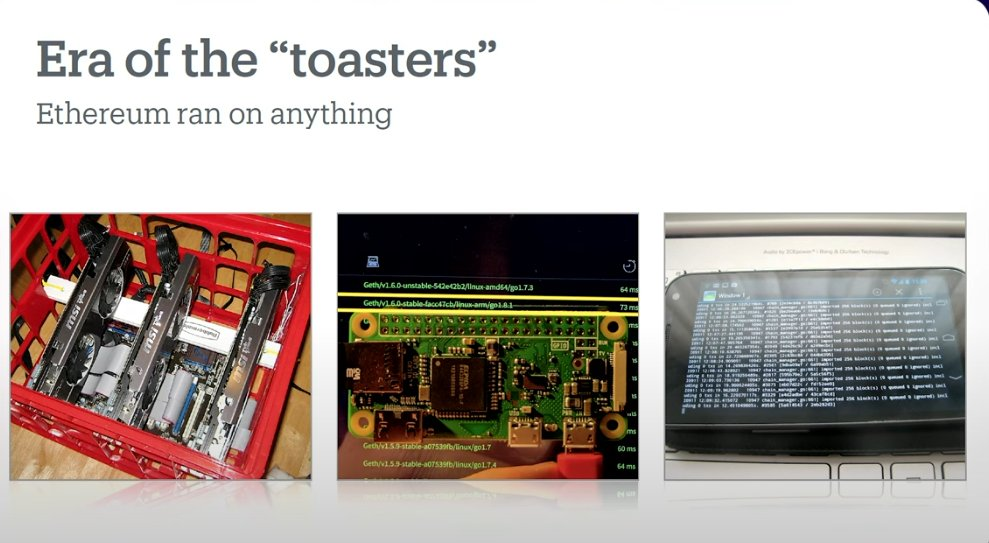
Left: Beer box; Middle: Raspberry Pi; Right: Smartphone
The best part was that nodes could run on anything, literally "anything." When Ethereum launched, most people did not want to buy expensive mining machines. Some bought a beer box from the supermarket and threw the machine inside. The other two images are systems I built myself, one being a Raspberry Pi computer, possibly the lowest-spec Raspberry Pi in history, but it could run an Ethereum full node. The other is my first smartphone, which could also successfully run a full node. 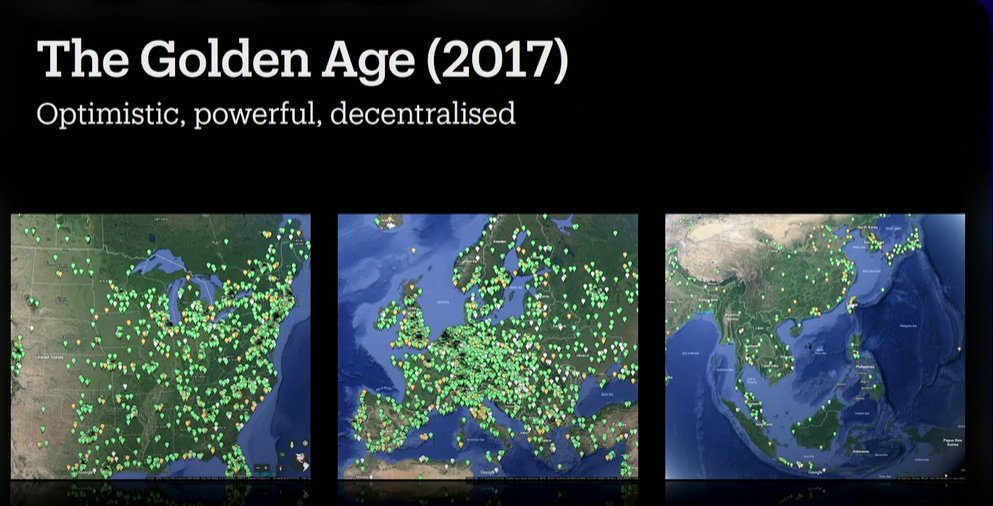
In 2017, Ethereum had tens of thousands of nodes scattered around the globe, and all these nodes were basically equal. Of course, some were more powerful, and some were a bit weaker. If a war broke out and someone tried to destroy the Ethereum network, they would find that no single node was important enough to be worth destroying. This was Ethereum's golden age—this is not just my opinion; if you look at the price trends, it was only 7% away from flipping Bitcoin's market cap! 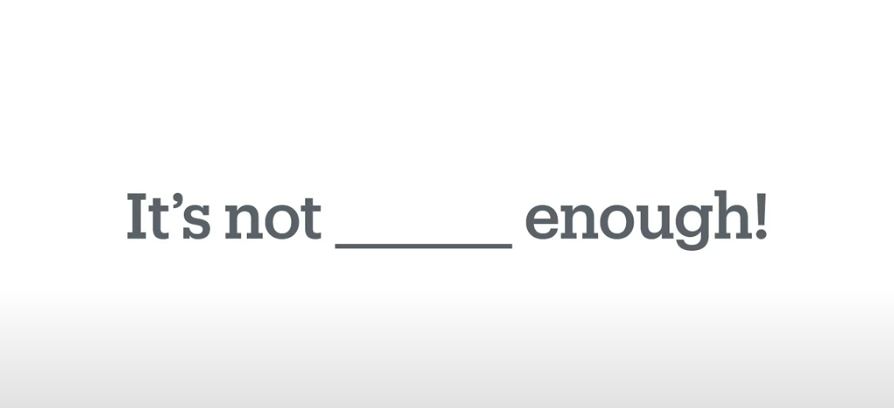
Unfortunately, after that, we entered the "not enough" era: you could say Ethereum transactions were not fast enough, not cheap enough, and final confirmations were not quick enough, with many different attributes to criticize. Yes, it wasn't fast enough, cheap enough, or sufficient in any aspect. But the question is, how do we fix it? This becomes complicated; fixing a decentralized system is very troublesome. If we centralize a bit, the repair process becomes much simpler and more natural. So we started to walk down a less ideal path. 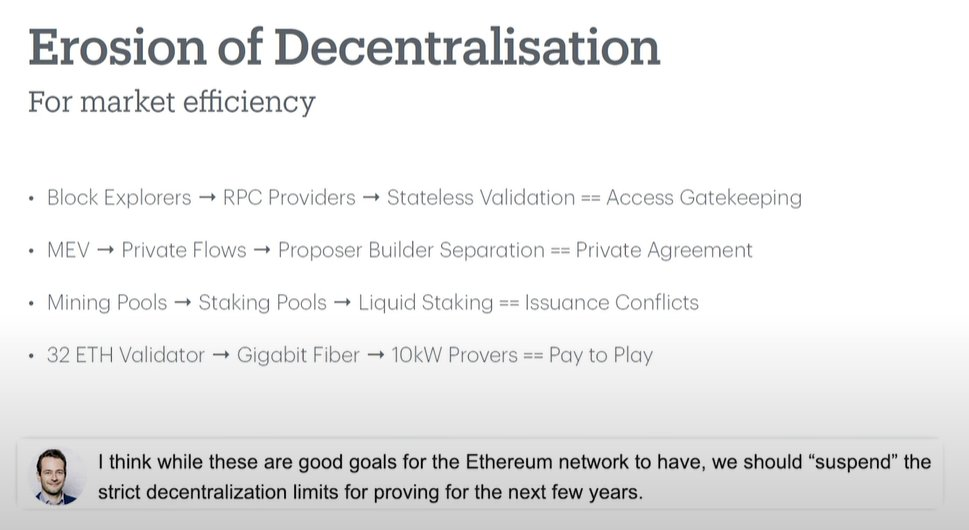
Earlier, I listed four attributes that I think are super important:
- Every node is equal
- Everyone can mine
- Everyone has access to transactions
- Everything is cheap
After the golden age, we had some incremental innovations. One small step was the block explorer. You could check address balances on Etherscan without running your own local node; the process was natural and completely harmless. Then people realized, wait a minute, can we let programs and applications use something similar, where programs don't have to maintain their own local nodes but can connect to services maintained by others? Thus, Infura and other RPC providers emerged. Technology developed step by step, and today, we are pursuing stateless validation, storing the entire state with external operators, and even validators should rely on external services.
Another topic is MEV. In the early days, all transactions were public, and then people began to abuse them with sandwich attacks, front-running transactions, and various operations. These are collectively referred to as MEV, and everyone agrees that MEV is bad. So what did we do? We lowered the threshold for MEV. We made it so easy that now that everyone can do it, it doesn't seem so bad. In my view, this is a terrible solution because we didn't fix the problem; we made it worse. People didn't want to be sandwich attacked, so private transaction pools and private order flows emerged. As miners, you could no longer see these transactions from the public transaction pool, so miners were also forced to rely on others' services.
From the miner's perspective, we can see a similar trend. After Ethereum launched, mining pools quickly appeared. Although mining pools are somewhat centralized, they are still limited by the physical world, constrained by GPU availability and electricity. After switching to proof of stake, staking pools replaced mining pools, and the physical limitations disappeared. Nowadays, you can quickly move all staked ETH from one pool to another, giving staking pools more power. Then liquid staking emerged, another step-by-step expanding technology, to the point where today, when any researcher talks about adjusting Ethereum's issuance, the primary concern is whether Lido will veto the proposal, and only then whether it is best for the network. This is a very bad situation. By the way, Lido is a very good player. I don't want to disparage them, but they do have veto power, and people need to be aware of that.
Lastly, due to technical reasons, after switching to proof of stake, the minimum staking amount for mining was raised to 32 ETH, which is about $100,000 at market price. This is a bad choice, significantly raising the threshold for people to run nodes. At first, everyone said, don't worry, we'll fix it; then it turned into, let's assume that everyone who wants to be a miner has at least $100,000, so let's go with that. Later, we also assumed that nodes would be equipped with high-speed fiber optic networks; after all, if you have $100,000, you should have a fiber optic network. Today, Vitalik believes that validator nodes need to meet a power supply capacity of at least 10 kWh per hour, as 10 kWh per hour is just the average electricity consumption of a regular household. This is Vitalik's exact words. However, in Romania (the location of the speech), if you live in an apartment, your electricity consumption is limited to 4 kWh per hour. If you live in a detached house with single-phase electricity, you are legally limited to 9.9 kWh per hour. Yes, reaching 10 kWh per hour requires a bit of luck.
In all these examples, everyone is trying to genuinely improve the system and make it more efficient; no one has malicious intent to undermine decentralization. But time and again, small problems keep arising, and we say, well, we know this isn't the best for decentralization, but you know we can improve it later, slowly resolve it, so let's just do it this way for now. 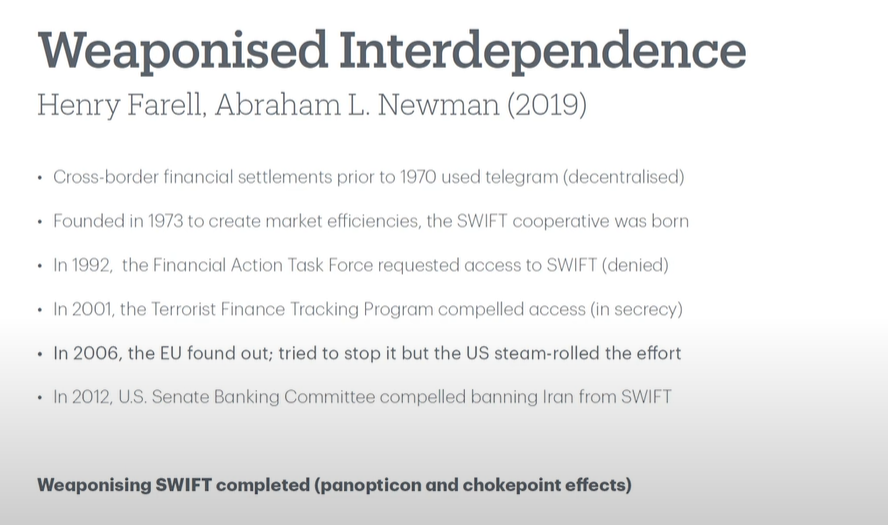
Everyone here wants to create a global settlement layer; we want to replace SWIFT because SWIFT is the "evil" banking settlement system. However, how many people know the origins of SWIFT?
Before the 1970s, banks settled transactions via telegraph, not the software on your phone, you know, but with old Morse code telegrams. This was a 100% decentralized system; a bank in New York could send messages to London, and a bank in London could settle transactions in Shanghai. It operated stably, albeit a bit poorly, a bit expensively, and a bit slowly, etc. Some smart people said we should make it more efficient—the SWIFT project was born from this pure and good idea, just wanting to make things a bit more efficient. They succeeded; a group of smart people spent over 20 years making the SWIFT system the global settlement layer.
In 1992, the U.S. government realized that SWIFT stored too much high-value information and requested access. The request was immediately denied, as SWIFT is a European company headquartered in Belgium, and the U.S. had no jurisdiction over SWIFT. So the U.S. waited for 10 years until 9/11 happened, which was when the floodgates opened. The U.S. enacted anti-terrorism laws that allowed them to do almost anything in the name of counter-terrorism. Even though they had no jurisdiction over SWIFT, SWIFT did have a backup data center in Arizona. The game was over; U.S. government officials walked into the Arizona data center and told them that from now on, they would access their data, and they could not tell anyone about it.
For the next five years, the U.S. government quietly studied all the data from the global payment network without anyone knowing.
In 2006, the European Union discovered this secret and tried to stop it but failed. It was a big uproar; I remember an EU commissioner saying that the U.S. ambassador was like a door-to-door salesman, coming day after day to persuade EU officials, saying, "No, you cannot remove our access." The U.S. crushed the EU with its power, ultimately forcing the EU to concede. In 2012, SWIFT finally became a weapon. That year, the U.S. government forced SWIFT to kick Iran out, equivalent to using an "economic nuclear bomb" against Iran—a term coined by an official executing the sanctions that year.
Once, we had a beautiful decentralized system, and gradually, we wanted to make it more efficient; no one wanted to destroy it or let it fall into the hands of enemies. The SWIFT team consisted of kind, smart people, collaborating across 200 countries and 11,000 institutions, trying to create a better payment network. However, 30 years later, the government controlled it, and another 10 years later, it became a weapon.
Back to Ethereum, we are still early. The slogan "Still early" is really good. In a few days, it will be the 10th anniversary of Ethereum. In my view, although we are starting to walk down a path similar to SWIFT, we are still far from real trouble. 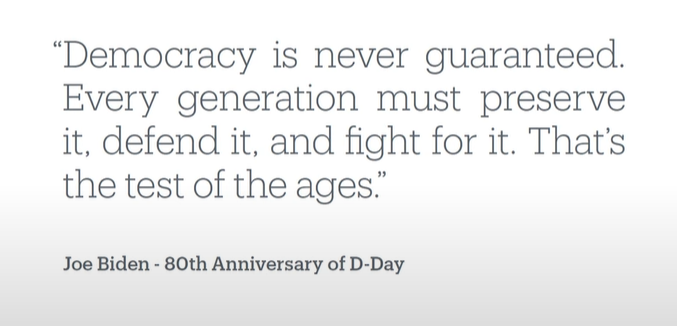
History may not repeat itself simply, but there are always similar rhymes. I think of a quote from Joe Biden, who said during his speech on the 80th anniversary of D-Day: "Democracy is not a given; every generation must defend it, fight for it." To me, decentralization is oddly similar to the concept of democracy vs. authoritarian government. If you look at China and Dubai, their governments handle affairs very efficiently and smoothly. If you look at the elections in Europe and the U.S. over the past few years, it has been chaotic and messy. But somehow, we tend to prefer chaos over super-efficient systems. Decentralization will never be as efficient, cheap, or fast as centralized systems. To maintain Ethereum's independence over the next 30 or 40 years, we must make trade-offs.
I want you to remember: as we pursue higher technical metrics, every small step of development should align with the overall system. Remember to examine where we started, where we are today, and where we are going. Keeping this mindset, perhaps we can avoid being devoured by the world.
Thank you all.
[Video link](https:// https://youtu.be/9WT-nsneEDA?si=RnZmcAe3Ow8w8Lmh)
免责声明:本文章仅代表作者个人观点,不代表本平台的立场和观点。本文章仅供信息分享,不构成对任何人的任何投资建议。用户与作者之间的任何争议,与本平台无关。如网页中刊载的文章或图片涉及侵权,请提供相关的权利证明和身份证明发送邮件到support@aicoin.com,本平台相关工作人员将会进行核查。




